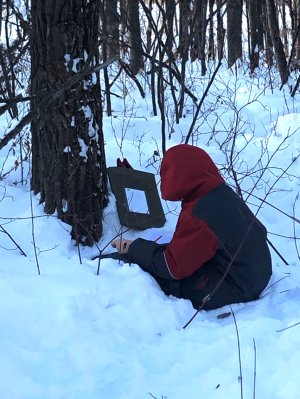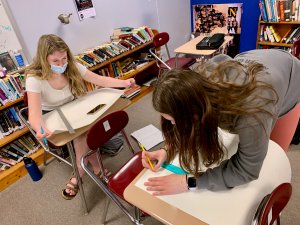In Schools, Finding Hope at a Hopeless Time
Research shows that hope is a measurable, learnable skill—and to feel hopeful, students and teachers have to work at it.
Your content has been saved!
Go to My Saved Content.In mid-February, three snowstorms knocked out the electricity for thousands of residents in Boyd County, Kentucky. As they waited for up to two weeks for the lights to come on, many residents were left snowbound in their homes in freezing temperatures. Two people died from hypothermia before power was restored.
The outages added insult to injury for a rural community struggling to keep students connected and engaged in remote learning for the past year, shared Christy Ford, a high school English teacher. With limited cell phone battery, Ford texted her students during the “dark days” to let them know she was thinking about them—and ask them what they’d do first when the power came on.

“During the time virtual school was ‘off the grid,’ I noticed that looking forward seemed to be the best use of my mental energy,” said Ford, who now plans to create a new assignment: “What’s the first thing you’ll do when things return to ‘normal’?”
While pandemic schooling has always been hard, it’s seemed to get harder as time has gone on, say Ford and other educators, who are desperately looking for ways to help students stay motivated. Teachers have reported that students increasingly see school as irrelevant and feel a sense of hopelessness about the future. Even with vaccinations and school openings increasing, there are reported upticks in youth depression, anxiety, and suicide attempts. Many teachers, too, share a deepening sense of disillusionment after a year of significant upheaval—and what is expected to be a challenging, slow transition back.
So what can educators do to instill hope in students, especially when many feel hopeless themselves? According to many research studies, people who are hopeful aren’t simply optimists or Pollyannas but are able to think proactively about the future and plan ahead to get there. Research shows that hope is a learnable, measurable skill, and one that has a sizable impact on students' success and persistence in school. Children who are hopeful are also found to have higher self-esteem and social skills, are more likely to set and achieve goals, and can more easily bounce back from adversity.
“People always think of hope as ‘squishy,’ but it’s not,” said Crystal Bryce, the associate director of research at the Center for the Advanced Study and Practice of Hope at Arizona State University. “Hope is cognition and a leading motivation that pushes people to act towards their goals. It’s a skill we have to work on and one that we can grow.”
According to researchers and psychologists like Bryce, small shifts in curriculum, assignments, and tasks can actually have an effect on how students see themselves and their world. By making some adjustments and bringing new activities, teachers can mitigate some of the hopelessness students feel—and, in turn, make themselves feel more hopeful too.
Don’t Sweep It Under the Rug
To feel more hopeful, address the elephant in the room. Both children and adults should acknowledge and address the tumult they’ve experienced this past year, said David Schonfeld, a pediatrician and director of the National Center for School Crisis and Bereavement at Children’s Hospital Los Angeles, which works with schools after crises like school shootings.
Not long after 9/11, Schonfeld said, one of his daughters came home from school, frustrated. “They haven’t talked at all about what happened on 9/11,” Schonfeld recalled her saying. “Right now, we’re learning about the War of 1812. Can you think of any way school could be less relevant to my life right now?’”
While learning about the War of 1812 is important, neglecting to discuss current realities can make students feel that school is out of touch and push them to disengage, said Schonfeld. That’s not to say educators should turn every class into a counseling session, but they should try to carve out time for students to share how they feel. Be careful not to minimize their feelings by making “them feel guilty for being upset about something that pales in comparison to someone else’s tragedy,” he cautioned.

Instead, coach students to focus on one or two things that are troubling them—a roadblock, for example—and address those specifically, said Phyllis Fagell, a school counselor in Washington, D.C. Fagell’s go-to is using a “worry monster” (a stuffed monster with a zippered mouth pouch) for younger students or a “worry box” for older students, where students can write down a worry and “set it aside.” She also recommends creating anonymous Google docs so that students can freely vent frustrations and brainstorm coping strategies to help.
“Kids can’t solve problems if they feel stuck and overwhelmed,” said Fagell. “A small setback can leave a kid feeling hopeless, but it often doesn’t take much to pull them back from the brink.”
Share success stories: Once children get some of their concerns off their chests, educators can focus their thinking forward—with hope. In lessons, integrate stories of people who have overcome tremendous hardships or failed repeatedly and then succeeded, experts recommend, making sure that all students in class can see their backgrounds reflected in the examples.
Making history: Teachers might also consider helping students frame current experiences as a “moment in time”—and one that will pass, eventually. Bring in examples of other past global crises or epidemics, said Michele Borba, a former teacher and nationally recognized education psychologist who is the author of Thrivers: The Surprising Reasons Why Some Kids Struggle and Others Shine. As a supplement, students can create time capsules or write letters to their future selves about their experiences, what progress was made, and what they see ahead.
A Mindset Shift
When students have the right frame of reference, educators can prime their brains to be more hopeful, according to research.
C.R. “Rick” Snyder, a well-known researcher of hope, found that students who scored higher on measures of hope had more agency to develop goals and set pathways to accomplish them—including finding alternative strategies if they had setbacks along the way.
Ask the right questions: A good starting place for teachers is regularly integrating specific question prompts into classroom activities that many already conduct—like morning meetings or entry or exit tickets—said Denise Larsen, a research professor and the director of Hope Studies Central, a research center at the University of Alberta.
Larsen, a former teacher who has studied hope for the last two decades, recommends having students answer the prompt “Today, I hope...” as a verbal or written response daily, if possible. Students can also journal about things they are hopeful and thankful for, or complete a broader exercise in which they reflect on their past successes or times they overcame obstacles.
Set goals with accountability: These prompts can develop into more comprehensive activities where students and teachers work together to tie a student’s hopes to specific goals. To make the goals manageable, teachers should help students prioritize and break them into smaller, targeted goals, or stepping stones, along with a Plan B if things don’t work out, said Bryce. Most important, the goals should be personalized to the child—not someone else’s goals for them.

High school English teacher Allison Berryhill recently conducted a “Dream It, Do It” activity in her class, for example. Students first watched Tim Urban’s TED Talk “Inside the Mind of a Master Procrastinator” and discussed how one might not achieve goals if they lack structure. Then, each student brainstormed 12 hopes for their future and selected one to focus on. Using a backward planning process, students developed plans to reach their goals—including conducting research and setting deadlines—and presented them to classmates for accountability.
While hopes and goals are closely related, a framing of hope sets a different tone—and one that may help students, especially those who are discouraged, to think futuristically, said Larsen. “There is a simple but powerful shift in the language when we move from goals to hope,” she said. “It’s possible to fail at a goal, but you can’t fail at a hope. Start with hope first.”
Opportunities for Impact
It can be a challenge, however, to think optimistically about the future amid so much instability and uncertainty, said Schonfeld and other experts.
In a classroom, teachers can help combat the feelings of powerlessness by giving students opportunities where they regain a sense of control. This, in turn, makes them feel more hopeful, according to a 2010 research study of adolescents ages 14 to 18. These can be small things, like the ability to choose activities to complete, an opportunity to share passions and interests, or having a second chance to improve.

Connect students to students: Educators should also consider larger impacts that students can have right now, say Borba and others. She recommends helping children see themselves as changemakers by sharing stories of children who have made a difference—even if the impact was small. Consider pairing older students and younger students together, or buddies within a class, Borba said, so that students can quickly see results from the small things they do that affect others.
Create community projects: Because hope is driven by the individual, children should be given a chance to brainstorm their own ideas for making an impact too. According to research, having hope for others can have a significant effect on how much hope people feel themselves—especially for children, said Larsen. In Amy Badger’s middle school class, students present ideas for how to bring hope to their community. The class then votes on the proposals and picks one to take on, including developing an action plan together for achieving it.
It’s normal for a person’s hope to ebb and flow, though, especially in tough times. Larsen suggested that as teachers try to stay steadfast at the helm, they find “tiny sparks” or “hits of hope,” like reminding themselves of all the times they impacted kids and didn’t realize it until later. One of the biggest ways to bring hope to children is through their relationships with supportive adults, she and others emphasize.
“My takeaway during dark times is I need to model strong and consistent behaviors for my students—even if I’m struggling with the same frustrations and sense of hopelessness myself,” Christy Ford said.
